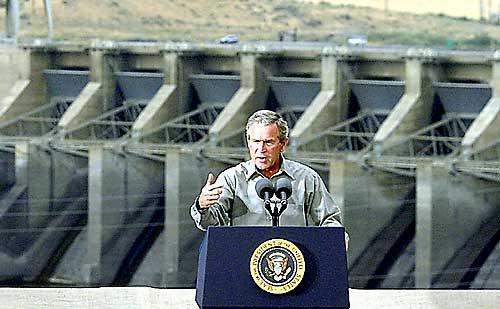forum
library
tutorial
contact

Wild Salmon Win Respite in US Court
by Brad Knickerbocker, staff writerThe Christian Science Monitor, April 17, 2007
|
the film forum library tutorial contact |

|
Wild Salmon Win Respite in US Courtby Brad Knickerbocker, staff writerThe Christian Science Monitor, April 17, 2007 |
 Ashland, Ore. -- The wild salmon in the Pacific Northwest - already at a fraction of their historic numbers and facing many threats, from sea lions to global warming - may be getting a reprieve.
Ashland, Ore. -- The wild salmon in the Pacific Northwest - already at a fraction of their historic numbers and facing many threats, from sea lions to global warming - may be getting a reprieve.
A federal appeals court has upheld a ruling that threatens to breach the biggest threats to their survival - four major dams in the Columbia River basin - if the US government doesn't come up with a realistic recovery plan.
The decision, rendered last week by the Ninth US Circuit Court of Appeals in San Francisco, represents the latest in a long line of court rulings throwing out salmon-recovery plans by White House administrations of both parties going back to 1993.
"I can strongly affirm that it is the policy of this administration to uphold the law faithfully," Bob Lohn, a regional administrator for the National Oceanic and Atmospheric Administration (NOAA), said after the ruling. "But when the underlying issues are difficult or contentious, there is often great debate about what the law means or how it should be applied."
The salmon's recovery is complicated, however, by a variety of factors, including growing development and climate change.
The dams are particularly controversial. President Bush has said he would not consider breaching or taking out any of the dams, which provide power, irrigation, and barge transportation - all viewed as essential to the region's economy. Under the latest administration plan, the eight dams along the Columbia and Snake Rivers (as well as the irrigation, flood control, and power generation they provide) are considered part of the landscape because they were built before the Endangered Species Act was passed in 1973. In other words, the administration argued, only the effects of dam operations and not the dams themselves should be considered under the Endangered Species Act.
But the appeals court last week found that point of view to be "little more than an analytical sleight of hand" that seemed to imply that salmon "could be gradually destroyed, so long as each step on the path to destruction is sufficiently modest."
"Statistically speaking," the court declared sardonically, "the dead fish were really alive." The court also lambasted NOAA, the agency charged with protecting endangered fish species, for taking a "cramped view" of its authority.
"This decision should compel the federal agencies to look at all recovery options - including removing the four lower Snake River dams, and develop a solution that works for people and fish," said Steve Mashuda of Earthjustice, the nonprofit law firm representing a coalition of fishing business and conservation groups in the case.
Salmon need the right amount of water at the proper temperature to spawn upstream, after which their offspring head out to the Pacific Ocean before returning to the place of their birth several years later to repeat the cycle. Dams, irrigation diversions, logging, mining, and urban development have made the river trips to and from the ocean increasingly difficult.
Before the eight dams were built on the Columbia and Snake rivers, some 16 million salmon a year filled annual fish runs. Today, that number is down to about 1 million fish, and 12 species of salmon are listed under the Endangered Species Act.
Meanwhile, the challenge of reversing the steady decline in salmon populations across an area the size of central Europe is becoming increasingly difficult because of growing commercial and residential development.
Now, say scientists, global warming is making the problem more difficult.
Earlier this month, research scientists from NOAA and the University of Washington in Seattle reported that climate change is likely to cause warmer water temperatures, lower spawning flows, and increased winter water flows - all of which could raise salmon mortality.
"Under assumptions of warming temperatures and shifts in local precipitation, these stream habitat attributes will change for the worse as far as salmon are concerned," said Mary Ruckelshaus, a NOAA fisheries scientist and coauthor of the study, which was published by the National Academy of Sciences.
An earlier University of Washington report found that climate change in the Puget Sound area has been taking place relatively rapidly.
Another relatively recent threat to salmon are the California sea lions that have been gobbling up salmon at the fish ladders designed to help adult salmon over the dams on the way upstream to spawn. Officials have tried scaring off the sea lions with firecrackers and rubber bullets, but it hasn't worked. Sea lions themselves are protected under the 1972 Marine Mammal Protection Act. Congress is now considering a bill that would allow Oregon, Washington, and Columbia River Indian tribes to kill a limited number of sea lions.
In the end, it is likely to be the dams that will have to be addressed if salmon are to survive.
The National Marine Fisheries Service and other federal agencies are expected to present a new strategy for the Columbia River basin next month. Under the Endangered Species Act, such plans must lead to the recovery of species headed toward extinction.
learn more on topics covered in the film
see the video
read the script
learn the songs
discussion forum
